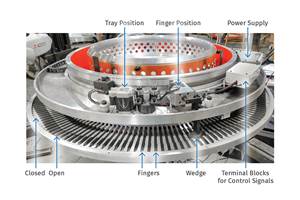Communication Is Key in Designing Blown Film Dies
Over the years I have bought, designed, or helped design quite a number of blown film dies.
Over the years I have bought, designed, or helped design quite a number of blown film dies. After few go-arounds, it amazed me how often the process of designing a die was treated as “magic,” with the thought that only a few anointed “die wizards” could actually do the job. Not so.
That being said, there are a few things these wizards do need to know before tackling your project. And if the one you’re working with does not ask for them, find another wizard.
First, a few basics: A die can run one material at one temperature and one output rate perfectly…if it is designed perfectly. To put it more scientifically (it is science, after all), a die is designed for one volumetric throughput of a material with specific viscosity characteristics. If you ask anything more of a die, something will be compromised somewhere. (Of course, some die designs are more forgiving than others).
The first thing your die designer needs to know is what are you planning to run on it, and how fast. This may sound obvious, but sometimes it is not communicated well. It is not enough to tell a designer, for example, that you’ll be running an 18% 2-MI EVA with a 1-MI HDPE in a 10/90 layer ratio at 1000 lb/hr. That information alone won’t get you the die you need. Rather, the die designer will need the actual rheology curves (tabulated raw data is even better) for the specific resin blends you are running. (Please note: It is the rheology of your blends that counts.) Provide them this rheological data at temperatures that straddle your operating conditions (typically three temperatures).
Always have a confidentiality agreement in place before sharing information with your designer. But if you have a product that is truly super-secret, remember that the designer generally only needs the rheology data, and throughput rates. The designer does not need to know if you’ll be running LDPE or LLDPE (though the rheology curves should provide a pretty good idea, in any event).
After you have given your die designer what he needs, there are some things you need to get from him—guarantees. The more general ones are listed here:
- Gauge uniformity: This should be defined up front. Is it two or three standard deviations total range? More importantly, how is it measured? By a micrometer of a given footprint? Every inch? With a beta gauge or a capacitance gauge on the bubble, or in the lab? At a certain speed/width, of data collection? The point is to be clear and specific in writing. This should only concern CD or TD variation, as the die designer has little control over the MD variation of your process.
- Layer Uniformity: Almost all coextrusion blown film dies are actually multiple dies “stacked” together in one manner or another. So each “die” module in the stack must be evaluated on its own. The rules are the same as outlined above. The methods of measuring layer thickness and uniformity are different, but should also be defined up front in writing. When defining layer thickness do not forget to specify volume vs. mass, as there can be a wide range of densities between polymers.
- Output vs. pressure drop and gauge uniformity: This is a good one to test your die designer and his software. When you get the die up and running, how close did he come to his calculated values? No one is perfect, but…. To be fair, when calculating the pressure drop, the rest of the system needs to be subtracted when throughputs are changed.
- Get drawings: The time to get an agreement to have detailed die drawings, both external and internal, is before placing the order. Most die makers will resist giving internal dimensions. (After all, this is the magic.) Sometimes you can get this information if you let them leave out the spiral, or distribution, section. This has worked for me in the past, as the non-distribution areas are my greatest interest as a processor. And if I really want the other dimensions, I can get them (and often have) by measuring them myself.
I recommend taking the die apart when it is first delivered, even though this may be an unpleasant, seemingly unnecessary process. Doing so will give your maintenance people the opportunity to see and learn what will be involved in their future work, and to prepare for it. Plus you can find any defects. And if the die maker refused to supply dimensions, you can get them at this time. (Or, a local machine shop has all the measuring tools and would be happy to do it for you for a marginal fee.)
About the Author
Eric Hatfield is manager of technology implementation at specialty film processor Clopay Plastic Products, Mason, Ohio. He can be reached at ephatfield@clopay.com.
Related Content
Masterbatch Creates Cavities, Helping Film Processors Boost Sustainability, Recyclability
Additive technology creates air pockets in film during orientation, cutting down on the amount of resin needed while boosting opacity, mechanical properties and recyclability.
Read MoreNew Blown-Film Cooling Technologies Set to Debut at NPE2024
Cooling specialist Addex to roll out new auto-profiling air ring for rotating dies, and new single-plenum air ring.
Read MoreNovel Air Ring Solves Gauge Variations for Film Processor
Crayex installs Addex gauge-controlling air ring built for rotating/oscillating dies on a problematic line and notices dramatic improvement in thickness variations.
Read MoreFollow These Tips to Fire Up Your Cold Blown Film Line
Firing up a cold blown-film line after a shutdown involves multiple pieces of equipment that all interact. Here’s a look at those components individually and some best practices on how to get your line up and running as quickly and safely as possible.
Read MoreRead Next
Lead the Conversation, Change the Conversation
Coverage of single-use plastics can be both misleading and demoralizing. Here are 10 tips for changing the perception of the plastics industry at your company and in your community.
Read MoreSee Recyclers Close the Loop on Trade Show Production Scrap at NPE2024
A collaboration between show organizer PLASTICS, recycler CPR and size reduction experts WEIMA and Conair recovered and recycled all production scrap at NPE2024.
Read More



















